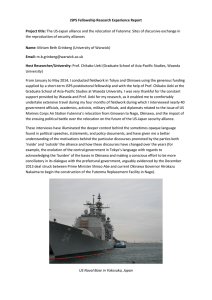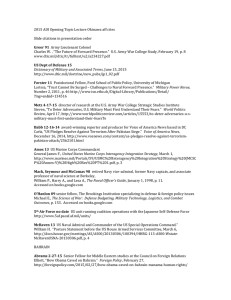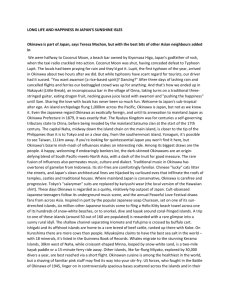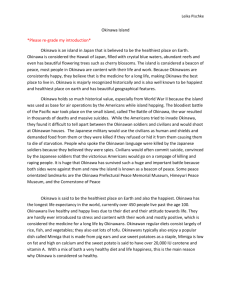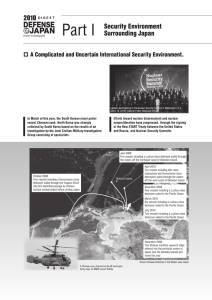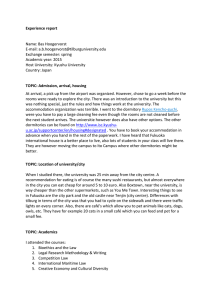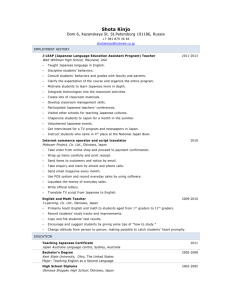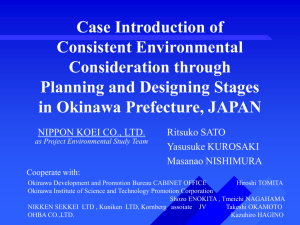DP Empirical Analysis on the Dynamics of Tourists
advertisement
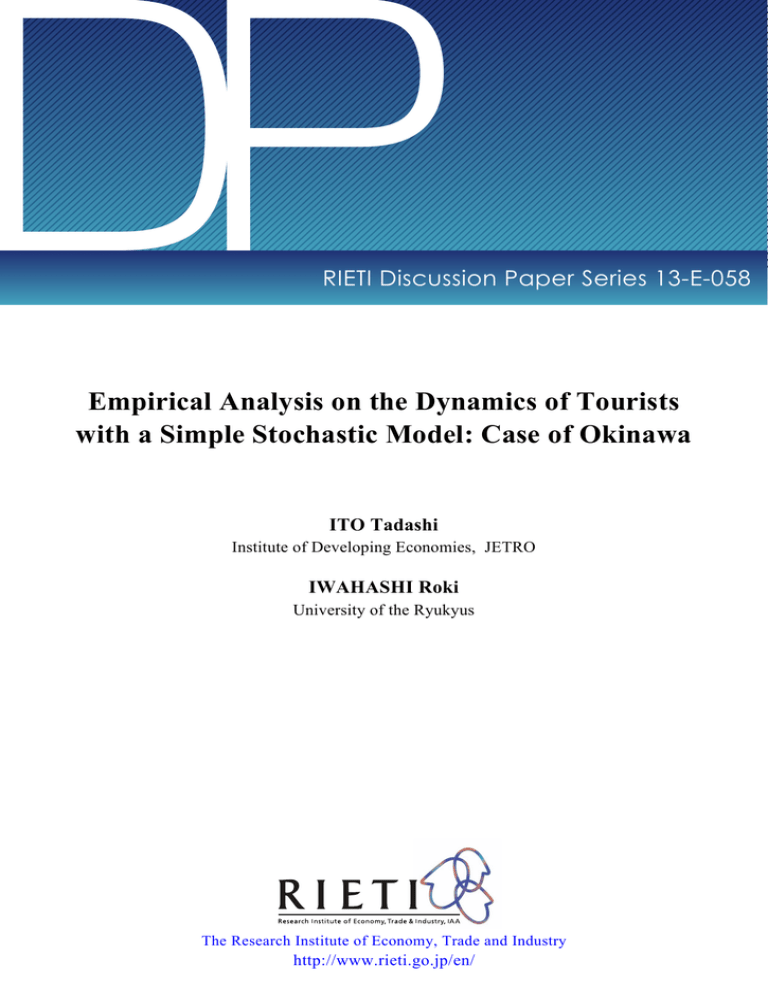
DP RIETI Discussion Paper Series 13-E-058 Empirical Analysis on the Dynamics of Tourists with a Simple Stochastic Model: Case of Okinawa ITO Tadashi Institute of Developing Economies, JETRO IWAHASHI Roki University of the Ryukyus The Research Institute of Economy, Trade and Industry http://www.rieti.go.jp/en/ RIETI Discussion Paper Series13-E-058 June 2013 Empirical Analysis on the Dynamics of Tourists with a Simple Stochastic Model: Case of Okinawa ITO Tadashi Institute of Developing Economies, JETRO IWAHASHI Roki University of the Ryukyus Abstract Departing from the conventional theoretical approach, which explains tourism demand by various kinds of determinants, this paper proposes a model in which the dynamics of the number of tourists is explained by probabilistic behaviors. More specifically, the model assumes two different probabilities—one for first-time travelers and the other for frequent travelers. Based on this theoretical framework, the paper empirically examines the dynamics of the number of tourists to Okinawa, Japan. We find that income and transport costs explain the probability of first-time visitors, but that they do not explain for that of repeat visitors. Instead, the congestion index, which reflects the busy lifestyle in large cities, does so. This suggests that tourism policy should differ depending on how well-established the location is as a tourist destination. Given that Okinawa is acknowledged as the foremost resort destination among the Japanese, the priority for the resources allocation of tourism promotion should be on the preservation of the natural environment and the original culture, thereby offering unusual experiences to the visitors. Keywords: Tourism demand, Stochastic model, Okinawa JEL classification: C23, L8 RIETI Discussion Papers Series aims at widely disseminating research results in the form of professional papers,thereby stimulating lively discussion. The views expressed in the papers are solely those of the author(s), and do notrepresent those of the Research Institute of Economy, Trade and Industry. This study is based on the project undertaken at Research Institute of Economy, Trade and Industry (RIETI) on regional development studies.We thank useful comments from the study group members of RIETI led by Professor Nakamura. 1 Introduction This study explains the dynamics of the number of tourists with a simple stochastic model. In our model, decision of making a journey is determined stochastically which depends on economical factors such as income and transportation cost. Assuming that the probability of making a journey differs between first travelers and frequent travelers, the model captures the tendency that can be typically seen for the dynamics of tourists where the exogenous shock persists for the subsequent periods. Based on our theoretical model, we empirically examine the dynamics of travelers using the data of travelers to Okinawa during 1998-2011. Okinawa island is located at the southern end of Japan, 400 miles away from the main island. Because of its tropical climate, clear blue ocean and unique natural environment, Okinawa is known as one of the foremost resort destinations among Japanese. In addition, Okinawa has a unique history. Until the 19th century, Okinawa was an independent kingdom called ”Ryukyu”, thus, today still preserves the traditional exotic culture and unique customs and habits of the past. After the second world war, Okinawa was occupied and under control of the American government until 1972, therefore, influenced by American culture. The mixed customs and culture of this land are particularly popular among visitors. Thus, it is not surprising that tourism has been the main industry in Okinawa. Figure 1 shows the time series of the annual number of domestic tourists to Okinawa, and revenue from tourism. Since its reinstatement to Japan, the number of travelers 2 to Okinawa has been growing consistently - today, nearly 6 million Japanese visit Okinawa every year1 . Likely, the revenue from tourism now represents a large part of GDP at Okinawa - 10.5% of GDP, which is the largest among Japanese prefectures. The multiplier effect of tourism industry in Okinawa in 2009 is estimated to be 662 billion yen, which is equivalent to 17.8% of GDP of Okinawa Prefecture (Okinawa Prefectural office), whereas its employment creation effect amounts to approximately 80 thousand employees, which is 12.8% of total employment in Okinawa. Also, given the recent economic growth of East Asian countries and the entries of direct flights to Okinawa2 , those who visit Okinawa particularly from East Asia is increasing dramatically. While the number of international visitors was 96,800 at 2006, it was 301,400 at 2011, which accounts for 5.0% of total visitors. Apart from the need of a study on Okinawa tourism, an advantage of taking Okinawa as our study subject is that, unlike Tokyo, Kyoto or other touristic places in Japan, the number of visitors is correctly and easily recorded, because air transport is practically the only way to reach Okinawa. An ever increasing importance of tourism industry for the economy of Okinawa calls for studies on the subject. Umemura (2004, 2007) analyzes the dynamics of tourists to Okinawa according to the traditional method of 1 Given the population of Okinawa (1.4 million), the number of visitors is remarkably large. For example, Hokkaido - the northernmost of Japan and another foremost resort destination among Japanese - has also 6 million domestic visitors while its population is four times as large as that of Okinawa. The situation of Okinawa much resembles that of Hawaii who has approximately 1.4 million population and 7 million visitors (including both domestic and international visitors). 2 At present, there are six foreign cities that operate direct flights between Okinawa that are Taipei, Taichung, Soul, Shanghai, Beijing, and Hong Kong. 3 economics of tourism. They conclude, using data during 1998-2003, that distance to Okinawa and per capita income well explain the number of visitors to Okinawa, estimating that 1% increase of distance decreases approximately 1.8% of visitors while 1% increase of income increases 2.7% of visitors. However, updating the data for 1998-2011, we found that either per capita income or distance (also transportation cost) no longer explains the number of tourists, which is the motivation of our study. We suspect two reasons for that. One stems from the way of data mining. While Umemura (2007) restricts its analysis only to prefectures where there are direct flights to Okinawa, we cautiously categorized Japanese 46 prefectures (except Okinawa) into 16 areas, in which direct flights to/from Okinawa are operated, according to how citizens at each prefecture make access to Okinawa. The other stems from the periods that we have updated. Although both per capita income and transportation costs are stable3 in Japan for recent years, the number of tourists toward Okinawa shows clear upward tendency. This inconsistency between the dynamics of travelers and economic factors motivated us to take a distinct approach to explain the mechanism of tourism demand4 . Departing from the conventional approaches, we introduce a simple stochas- 3 Income and transportation costs are even slightly decreasing and increasing respectively during the period. 4 Initially, we thought that the entry of low cost carrier (L.C.C) explains the puzzle. As for Okinawa airport, Skymark Airlines has operated between Narita since 2006, Fukuoka since 2008, Kobe since 2009, and Nagoya since 2011, whose fare is approximately 40% lower than the traditional full service airlines (F.S.A). However, we did not find any empirical evidence that the entry of Skymark Airlines has contributed to the increase of visitors to Okinawa. The data rather suggests that the number of L.C.C users are absorbed by the decrease of F.S.A. users. 4 tic model5 . In our model, income and transportation cost do not directly determine the number of travelers but they explain the probability of making a journey, and thus, indirectly influence the number of travelers. It is also assumed that the probability of making a journey differs between first travelers and frequent travelers. With this feature, the exogenous shock persist for the subsequent periods, therefore, possible to maintain upward tendency even if income or transportation costs are constant. The distinction of the probabilities between first travelers and frequent travelers is important because the number of people who visited Okinawa at least once has reached 43 million persons according to our estimation from the data on repeater rates complied by the Okinawa prefectural office, which represents approximately one-third of the population of Japan, and thus, a further increase of first travelers cannot be largely expected. Given the decreasing total population of Japan, the focus on frequent visitors is even more called on. In line with the theoretical model we develop, the dynamics of tourists toward Okinawa during 1998-2011 is studied. We found that, for those who first travel to Okinawa, per capita income and transportation cost to Okinawa affects possibility of making a journey, while they have nothing to do with frequent travelers. We found that citizens at large cities are more likely to become frequent visitors to Okinawa, therefore, variable such as congestion index more explains the 5 We mention the conventional approaches as studies in which the determination of tourism demand is directly explained by various determinants. Gray (1966) and Barry and O’Hagan (1971) are pioneering works that study tourism demand with econometric methods. Stabler, Papatheodorou, and Sinclair (2010) and Vanhove (2010) survey various approaches that used for the quantitative analysis of tourism demand. 5 decision of frequent travelers rather than income and transportation cost. This paper is organized as follows. The theoretical model is developed in Section 2. The data we use are explained in Section 3. The empirical analyses are done in Section 4. 2 Model In this section, we develop a theoretical model that explains the dynamics of the number of travelers. The model consists of two regions which we denote as region i and j. We assume that decisions of citizens at region i on whether they travel to region j at each period are taken stochastically. Those who have never visited region j at period t are assumed to travel to region j with probability pt , while the probability differs for those who have ever traveled to region j, which we denote as qt . One way of justifying this assumption is the imperfect information. Since we only have limited information about unfamiliar places, the experience at destination updates our information, thus, changes our aptitude to visit the place again. Note that, in principle, qt can either be larger or smaller than pt . Let us denote the population of region i at period t as Nt , the population of those who have not visited region j yet at period t as Nt0 , and the population of those who have ever visited region j at period t as Nt1 . Then, at , which denotes the number of visitors from region i to j at period t, can be expressed as at = Nt0 pt + Nt1 qt . 6 (1) In the case where pt , qt , and Nt are constant over time, it holds Nt0 = (1 − p)t−1 N, (2) Nt1 = (1 − (1 − p)t−1 )N. (3) thus, at = (1 − p)t−1 N p + (1 − (1 − p)t−1 )N q. (4) Equation (4) can be rewritten as at = q − (q − p)(1 − p)t−1 , N (5) thus, the number of visitors to region j is initially (when t = 1) pN , increases exponentially over time, and converges to qN at the steady state (when t → ∞) as shown in Figure 2 (benchmark). Note that the larger the p is the faster the number of visitors converges to the steady state while the larger the q is the larger the number of visitors at the steady state is. Figure 2 also exhibits the impact of the changes in p and q on the dynamics of the number of tourists. Notice that Nt0 and Nt1 are not affected by the marginal change of p and q at period t. Therefore, it holds that dat = Nt0 , dp dat = Nt1 . dq (6) (7) Thus, given the marginal change of p and q, the number of travelers at next period increases Nt0 ∆p and Nt1 ∆q respectively. As shown in Figure 2, the 7 increase of p does not change the number of travelers at steady state though it makes faster to converge to the steady state. On the other hand, the increase of q raises the number of travelers at the steady state. In addition, ) is decreasing while that it is obvious that the marginal impact of p on at ( da dp of q on at ( da ) is increasing. Therefore, it is reasonable to pursue strategies dq that increase p (try to make the transportation cost cheaper or try to send attractive publicity, for example.), when Nt0 is small enough, thus when the region is not yet acknowledged as a major tourist spot. As the region become popular among travelers, on the other hand, it gets reasonable to pursue strategies that increase q (try to plan facilities or events that satisfy frequent visitors, for example). The repeat ratio (the ratio of repeated travelers) is often regarded as a target of importance for policy maker on tourism6 . However, our model tells that policies of increasing p and q respectively have quite different impacts on the repeat ratio. The repeat ratio (denotes as R) can be expressed, by definition, as Nt1 q . Rt = 0 Nt p + Nt1 q (8) Figure 3 captures the impact of the marginal increase in p and q on Rt . Given that Nt0 and Nt1 are independent of the change of p and q, the repeat ratio jumps downward when p increases, while the opposite holds when q increases. However, the repeat ratio approaches to an unity much faster when p increases since the speed of convergence to the steady state is much 6 See Miyagi (2009), for example, on the discussion of repeat ratio. 8 faster then. 3 Data This section explains the data used for our empirical study. At present, 16 regions have direct domestic flights between Okinawa, which are Tokyo, Kansai, Nagoya, Fukuoka, Sendai, Niigata, Komatsu, Shizuoka, Hiroshima, Okayama, Takamatsu, Matsuyama, Nagasaki, Miyazaki, Kumamoto, and Kagoshima. Tourism Policy Division at Okinawa Prefecture publishes monthly statistics for the number of visitors to Okinawa for each of these regions since 19987 . We have classified Japanese 46 prefectures (except Okinawa) into 16 regions according to which airport citizens at each prefecture are supposed to use so as to reconstruct figures such as population and GDP per capita. Table 1 shows how we classified 46 prefectures into 16 regions which have direct flights between Okinawa. While there are two airports at Tokyo area (Haneda airport, Narita airport) and three airports at Kansai area (Kansai airport, Itami airport, Kobe airport), we aggregated these multiple airports into a synthesized one in each area. Citizens at some prefectures need to make transfer in order to reach Okinawa. For example travelers from Hokkaido, since there is no direct flight between Hokkaido and Okinawa, need to make 7 On our study, the number of travelers is used as an indicator of tourism demand. Generally, other indexes such as average expenditure or average length of stay per capita can be an indicator of tourism demand. However, we found that both average expenditure and average length of stay are fairly stable for the past 20 years (approximately 70,000 yen and 3.8 days). Moreover, these data are only available as aggregate data for all the visitors, but not by regions. 9 transfer at Tokyo. In this case, we have categorized Hokkaido into Tokyo region as we can not distinguish who are from Hokkaido via Tokyo and who are directly from Tokyo. Citizens at other prefectures have a possibility of using distinct airports. For example those who live in Nagano prefecture may use either Niigata airport or Tokyo airport (While Niigata is nearer, Tokyo is more convenient). In this case, we assume that half of the citizens at Nagano prefecture use Niigata airport while the other half use Tokyo airport (shown in the parentheses at Table 1). Explanatory variables that we use are transportation cost (including both air fare and inland fare), income per capita, population, and index of congestion for each region. As for the air fare, we use the average of normal fare during 1998-2011. Ministry of Land, Infrastructure, Transport and Tourism publishes air fare for each of the flight, which is updated every half a year. As is well known, there are various kinds of discount air fares. Out of these airfares, normal fares are used in our analysis because choosing one or several discount airfares from many kinds of the fares is arbitrary, and more importantly the discount rates of various kinds of discount fares from normal fares are almost constant across airports and time. Thus, the choice of the type of airfares does not affect the elasticity this paper examines8 . We have also 8 Given the common feeling among Japanese citizens of ever decreasing prices of package tours, probably because of advertisement of super cheap package tours, we have meticulously checked the prices of package tours to Okinawa by perusing the pamphlets of JTB (Japan Travel Bureau) and by checking the data provided to us by Okinawa prefectural office for the past 15 years. Somewhat surprisingly, we have found the package tour prices have not shown a decreasing tendency at all, or even increasing in recent years (probably because of the increase of airfares). In addition to this, given that the number of super cheap tickets is extremely limited, we believe that our use of normal fares is innocuous. 10 derived inland fare by calculating the fare that one is supposed to pay when he travels from prefectural capital to the airport he uses9 . As an index of congestion, we use the time loss per km caused by traffic jams. Descriptive statistics of the explanatory variables are summarized in Table 2. We have restricted our analysis only to the domestic travelers. International travelers are excluded not because they are unimportant but because of the data limitation. It is only five years or less since the direct international flights have operated to Okinawa, thus the number of samples is not enough for the analysis. Actually, we did not get significant results using the data of international travelers. 4 Empirical Analysis In this section, in line with our theoretical model, p and q for each of the region are estimated. Then, we attempt to explain the difference of p and q among regions so as to understand the dynamics of tourists. Given that p and q are sufficiently small, we approximate (1 − p)t−1 as 1 − p(t − 1) to get ai,t = (1 − qi + pi )pi + pi (qi − pi )t Ni,t (9) from Equation (5), where i corresponds to each of the region, and t correspond to the monthly period. Thus, p and q for 16 regions that have direct flight between Okinawa are estimated by the linear Ordinary Least Squares 9 As for regions that consists of multiple prefectures, inland fairs are computed as a weighted-average of the population size of each prefecture. 11 (OLS) estimation where proportion of monthly visitors to Okinawa is explained by time. As ai,t are monthly data during 1998-2011, January 1998 is regarded to be t = 1, and December 2011 to be t = 168. Then, the estimated coefficient corresponds to pi (qi − pi ) and the estimated constant corresponds to (1 − qi + pi )pi , which enables us to identify pi and qi . Table 3 summarizes the estimation results. The estimated values of p are statistically significant for all 16 regions while that of q are statistically significant for 14 regions with exception of Shizuoka and Nagasaki. Kagoshima has the largest p (0.00758), meaning that 0.76% of citizens at Kagoshima region who have not yet traveled to Okinawa are predicted to visit Okinawa within a month (or 9.12 % within a year), followed by Fukuoka (0.0063), Kansai (0.00324), Tokyo (0.00285) and Nagoya (0.00249). Regions with low p contain Sendai (0.00062), Matsuyama (0.00067), Shizuoka (0.00087), and Okayama (0.00089). The estimated values of q are much more dispersed from the largest 0.01289 (Takamatsu) to a negative value of -0.00085 (Niigata). Niigata observes the only negative value of q, which is hard to interpret. The gap between p and q are also tabulated at Table 3. Within 14 regions with significant p and q, 4 regions (Niigata, Hiroshima, Kumamoto, Kagoshima) observe small q compared to p. Thus, once citizens at these regions travel to Okinawa, they tend to be more unwilling to visit Okinawa again. Rest of 10 regions observe positive q − p, meaning that people at these region are more likely to travel again once they visit Okinawa. Then, what causes the difference of p and q among regions? Our finding 12 is that the difference of p can be explained by economic factors such as per capita income and transportation cost while q can not. Table 4 shows the regression results of p on per capita income and transportation cost by the OLS. Transportation cost is defined as the sum of both air fare and inland fare. As for the place where one has not been yet, it makes sense that the decision of whether one chooses there for his vacation largely depends on how rich he is and how much it costs. According to Table 4, both 1% increase of income and 1% decrease of transportation cost result in 3%-4% increase in p. However, the same estimation for q or q − p has yielded statistically insignificant coefficients, thus indicates that income and transportation costs are no longer important for the decision of frequent visitors. Then, what makes the tourists return to Okinawa again? The regions at which the gap between p and q is large are Takamatsu (0.0119), Tokyo (0.0041), Nagoya (0.0032), and Kansai (0.0024), indicating that citizens especially at large cities are more likely to become frequent visitor to Okinawa. This result makes us conjecture that some factors which differentiate between Okinawa and big cities are the drivers of the gap between p and q. Namely, people who first visit Okinawa appreciate something far from everyday life, such as the now-well-known slow and easy life style of Okinawa. Thus, the citizens of busy cities may be more likely to appreciate the slow life of Okinawa and become frequent visitors. To test this hypothesis, q − p is regressed on congestion index. As Table.5 shows, the index has shown statistically significant coefficient. 13 Robustness check (Seemingly Unrelated Regressions) When we estimate many equations, regressions per each equation (termed “ limited information model ” in econometrics literature) may not be the best linear unbiased estimator. When there is a contemporaneous correlation of errors across equations, regressions of the whole system (termed “ full information model ”or“ seemingly unrelated equations model (SUR model) ” by the generalized least squares yields the best linear unbiased estimator. To see if there is a correlation of errors across equations, we have estimated a SUR model for the system of equations. Breusch-Pagan test of independence was rejected at 0.1% significance level, which indicates that there is indeed a correlation across errors. Our estimation satisfies a necessary condition for SUR that the number of observations must be larger than the number of equations of the system. Otherwise, the variance-covariance matrix will be singular, and thus non-invertible, rending estimations impossible. However, this is only a necessary condition. Depending on the data, the variancecovariance matrix might still be singular10 . Although SUR of 16 airports encounters the problem of non-singularity, that with 14 airports without two airports which exhibit statistically insignificant coefficient by OLS have yielded the estimation results. The coefficient estimates of p and q by SUR are in Table 6. Coefficient estimates for the determinants of p and q are in Table 7 and Table 8, respectively. They are statistically significant and show similar numbers to the cases of OLS. 10 For mote detail, see Srivastava and Giles (1987), for example. 14 5 Conclusion Because of the poor explanatory power of the existing models in the literature for the recent number of tourists to Okinawa, which attempts to explain the number of tourists by GDP, GDP per capita, and transport costs, this study proposes a model in which the dynamics of the number of tourists is explained by probabilistic behaviors. More specifically, the model assumes two different probabilities, the one for first travelers and the other for frequent travelers. Based on this theoretical framework, the paper empirically examines the dynamics of the number of tourists to Okinawa, Japan. We find that whereas income and transport costs explain the probability of first visitors, they do not explain the probability of repeated visitors, but congestion index, which represents how much busy life-style each region has. This suggests a policy implication for Okinawa. Now that the number of people who visited Okinawa at least once reaches 43 million persons, it is widely accepted in the society of Okinawa that the further promotion of tourism in Okinawa rests not on first visitors but on so called “ repeaters ”. The above finding of ours suggests that the priority for the resources allocation of tourism promotion should be on the preservation of natural environment and original culture of Okinawa and thereby solidifying the image of a peaceful, natural environment rich, slow life style island. 15 Acknowledgments We thank useful comments from the group members of RIETI study group led by Professor Ryohei Nakamura. We are also grateful to Okinawa prefectural office and to the Library of Tourism and Culture (Japan Travel Bureau foundation) for providing us with the data and for answering to our queries on the data. References [1] Barry, K. and O’Hagan, K. (1971) “An econometric study of British tourist expenditure in Ireland.” Economic and Social Review 3: 143161. [2] Gray, H.P. (1966) “The demand for international travel by the United States and Canada.” International Economic Review 7: 83-92. [3] Miyagi, H. (2009) “Okinana Kankou Ni Okeru Repeat Kyaku Kakutoku No Torikumi (An approach for promoting repeated visitors in Okinawa tourism)” [4] Okinawa Tourism Policy Division (2011) “A Handbook of Okinawa Tourism” Okinawa Prefecture [5] Srivastava, V. and Giles, D. (1987) Regression Equations Models., New York, Dekker. 16 [6] Stabler, M., Papatheodorou, A. and Sinclair, M. (2010) The Economics of Tourism., Routledge. [7] Umemura, T. (2004) “The prospect of Okinawa Tourism from a viewpoint of Global Trend.” Ryukyu University Economic Review 68: 87-122. [8] Umemura, T. (2007) “Re-Estimation of a Gravity Model Analysis of the Domestic Tourists to Okinawa.” Journal of Tourism Sciences 1: 45-54. [9] Vanhove, N. (2010) The Economics of Tourism Destination., Elsevier. 17 Table 1: Classification of 16 Regions 16 Regions Tokyo 46 Prefectures Hokkaido Aomori Gunma Saitama Kanagawa Yamanashi Kansai Osaka Kyoto Nara Wakayama Nagoya Aichi Gigu Fukuoka Fukuoka Yamaguchi Sendai Miyagi Akita (Iwate) Niigata Niigata (Nagano) Komatsu Toyama Ishikawa Shizuoka Shizuoka Hiroshima Hiroshima Okayama Okayama Tottori Takamatsu Kagawa Tokushima Matsuyama Ehime Kochi Nagasaki Nagasaki Miyazaki Miyazaki Kumamoto Kumamoto Kagoshima Kagoshima 18 Ibaraki Chiba (Iwate) Hyogo Tochigi Tokyo (Nagano) Shiga Mie Oita Yamagata Fukushima Fukui Shimane Table 2 :Descriptive statistics of the explanatory variables Regions air fare (yen) Tokyo 35456 Kansai 30208 Nagoya 32910 Fukuoka 23453 Sendai 45145 Niigata 44645 Komatsu 36096 Shizuoka 39800 Hiroshima 27977 Okayama 29975 Takamatsu 29920 Matsuyama 27075 Nagasaki 24673 Miyazaki 24468 Kumamoto 23716 Kagoshima 22725 inland fare population (yen) (thousand) 1581 44000 897 20814 1515 11380 1838 7703 2835 7321 1399 3458 3141 3068 1000 3792 1300 2863 2843 3251 1996 1788 1413 2202 800 1430 340 1132 670 1814 1400 1708 19 GDP capita (1000 yen) 4446 3863 4389 3831 3553 3692 4033 4330 3977 3526 3581 3258 2997 3123 3060 3272 congestion (min/km) 25.8 30.3 32.1 17.4 353 11.5 15.3 34.4 13.7 8.7 14.5 9.2 11.8 7.2 11.6 7.8 Table 3 :Estimated value of p and q Regions p̂ q̂ Tokyo 0.00285∗∗ 0.00690∗∗ Kansai 0.00324∗∗ 0.00559∗∗ Nagoya 0.00249∗∗ 0.00573∗∗ Fukuoka 0.00633∗∗ 0.00740∗∗ Sendai 0.00062∗∗ 0.00178∗∗ Niigata 0.00094∗∗ −0.00085∗∗ Komatsu 0.00097∗∗ 0.00171∗∗ Shizuoka 0.00087∗∗ -0.00071 ∗∗ Hiroshima 0.00230 0.00153∗∗ Okayama 0.00089∗∗ 0.00247∗∗ Takamatsu 0.00100∗∗ 0.01289∗∗ Matsuyama 0.00067∗∗ 0.00252∗∗ Nagasaki 0.00139∗∗ 0.00169 Miyazaki 0.00210∗∗ 0.00279∗∗ Kumamoto 0.00241∗∗ 0.00066∗∗ Kagoshima 0.00758∗∗ 0.00647∗∗ * and ** indicate statistical significance at 10 % q̂ − p̂ 0.00405 0.00235 0.00324 0.00107 0.00116 -0.00179 0.00074 -0.00158 -0.00077 0.00158 0.01189 0.00185 0.00030 0.00069 -0.00175 -0.00111 and 5 % respectively Table 4 :Estimation results for p by OLS Log of p Coef. std. err. t ∗∗ Log of GDP per capita 3.21 1.21 2.66 ∗∗ Log of transport cost −3.23 0.73 −4.80 Constant 8.11 7.39 0.47 Number of observations = 14 R-squared = 0.540 * and ** indicate statistical significance at 10 % and 5 % respectively 20 Table 5 :Estimation results for q − p by OLS q−p Coef. std. err. t Congestion 0.00223∗∗ 0.00064 3.48 Constant −0.00409∗ 0.00019 −2.20 Number of obs. = 14 R-squared = 0.104 * and ** indicate statistical significance at 10 % and 5 % respectively Table 6 :Estimated value of p and q by SUR Regions p̂ q̂ ∗∗ Tokyo 0.00370 0.00727∗∗ Kansai 0.00273∗∗ 0.00583∗∗ Nagoya 0.00200∗∗ 0.00700∗∗ Fukuoka 0.00634∗∗ 0.00750∗∗ Sendai 0.00059∗∗ 0.00274∗∗ Niigata 0.00052∗∗ −0.00229∗∗ Komatsu 0.00081∗∗ 0.00182∗∗ Hiroshima 0.00177∗∗ 0.00071∗∗ Okayama 0.00068∗∗ 0.00332∗∗ Takamatsu 0.00082∗∗ 0.01289∗∗ Matsuyama 0.00067∗∗ 0.00253∗∗ Miyazaki 0.00206∗∗ 0.00282∗∗ Kumamoto 0.00229∗∗ 0.00087∗∗ Kagoshima 0.00671∗∗ 0.00574∗∗ * and ** indicate statistical significance at 10 % 21 q̂ − p̂ 0.00357 0.00310 0.00501 0.00116 0.00215 -0.00281 0.00101 -0.00106 0.00264 0.01189 0.00170 0.00076 -0.00142 -0.00097 and 5 % respectively Table 7 :Estimation results for p by SUR Log of p Coef. std. err. t Log of GDP per capita 3.24∗ 1.63 1.98 Log of transport cost −3.51∗∗ 0.79 −4.44 Constant 10.80 9.19 1.18 Number of observations = 14 R-squared = 0.563 * and ** indicate statistical significance at 10 % and 5 % respectively Table 8 :Estimation results for q − p by SUR q−p Coef. std. err. t ∗∗ Congestion 0.00290 0.00080 3.63 ∗∗ Constant −0.00529 0.00242 −2.19 Number of obs. = 14 R-squared = 0.076 * and ** indicate statistical significance at 10 % and 5 % respectively 22 Figure 1: The nu umber of visitors and the revenue e from tourism to Okina awa (1972-2 2011) number of tourists Figure 2: Dynamics of the number of tourists by changes in p and q a (with increase in p) a (with increase in q) a (benchmark) 0 time 1 Figure 3: Dynamics of repeat ratio by changes in p and q 0.9 0.8 0.7 repeat ratio 0.6 0.5 0.4 0.3 R (benchmark) R (with increase in p) R (with increase in q) 0.2 0.1 0 time
